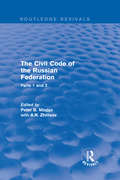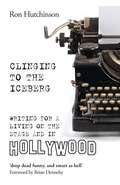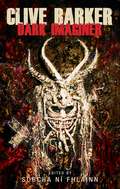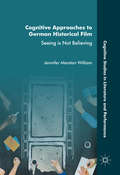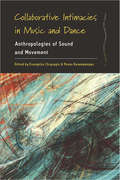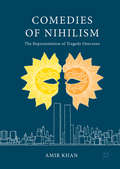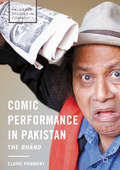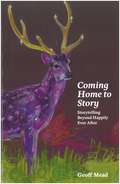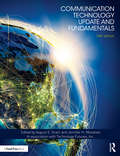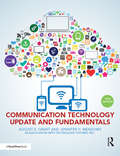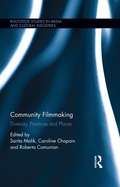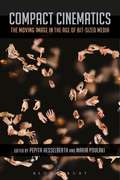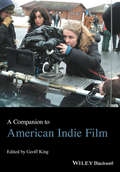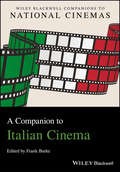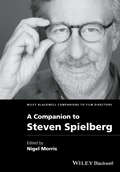- Table View
- List View
The Civil Code of the Russian Federation: Parts 1 and 2 (Routledge Revivals)
by Peter B MaggsThis title was first published in 1997: This is the definitive English translation of the new Russian Civil Code (Parts 1 and 2), often referred to as "the second Russian Constitution". The Civil Code of the Russian Federation is the result of a collaborative effort of a leading United States expert on Russian law and of the staff of the Private Law Research Center attached to the Office of the President of the Russian Federation -- the Center that had primary responsibility for drafting the new Civil Code. The authoritative introduction, complete table of contents. and comprehensive index combine to set this work far beyond the utility of any existing translations of the Civil Code. It will be a must-have resource for government, law and international business collections.
Clinging to the Iceberg: Writing for a Living on the Stage and in Hollywood (Oberon Books)
by Ron HutchinsonWickedly funny, insightful, often absurd but always true, Clinging to the Iceberg explores the inner workings of the business of writing for hire. It’s written by someone whose career has spanned over forty years on stage and on screen, including thirty lucrative and sometimes uproarious ones in Hollywood. Genuinely laugh-out-loud, it will astound and inspire and along the way reveal the REAL tricks of the dialogue writers’ trade.Hutchinson takes us through his successful career via hilarious anecdotes including a near-death experience on Venice Beach, being paid by Dreamworks to not actually work for them, and struggling to stay sane on location on one of the great movie flops of all time.
Clive Barker: Dark imaginer
by Sorcha Ní FhlainnA necessary and timely study of Barker’s influence in dark fantasy, gothic and horror studies. The book features twelve groundbreaking essays on Barker’s creative legacy and influence, and reevaluates his celebrated and lesser known works in fiction, film and visual art, from the Books of Blood (1984–85) to The Scarlet Gospels (2015).
Clive Barker: Dark imaginer
by Sorcha Ní FhlainnClive Barker: Dark imaginer explores the diverse literary, film and visionary creations of the polymathic and influential British artist Clive Barker. In this necessary and timely collection, innovative essays by leading scholars in the fields of literature, film and popular culture explore Barker’s contribution to gothic, fantasy and horror studies, interrogating his creative legacy. The volume consists of an extensive introduction and twelve groundbreaking essays that critically reevaluate Barker’s oeuvre. These include in-depth analyses of his celebrated and lesser known novels, short stories, theme park designs, screen and comic book adaptations, film direction and production, sketches and book illustrations, as well as responses to his material from critics and fan communities. Clive Barker: Dark imaginer reveals the breadth and depth of Barker’s distinctive dark vision, which continues to fascinate and flourish.
Cognitive Approaches to German Historical Film: Seeing is Not Believing
by Jennifer Marston WilliamThis book explores how minds at the movies understand minds in the movies and introduces readers to some fundamental principles of Cognitive Studies—namely conceptual blending, Theory of Mind, and empathy/perspective-taking—through their application to film analysis. A cognitive approach to recent popular historical films demonstrates cinema’s potential to stimulate viewers’ critical thinking about crucial events of the past century. Diverging from the focus on narrative processing in traditional cognitivist theory, this book examines film reception and production in the context of the latest developments in cognitive and social psychology. Turning to German cinema as a case study for this interdisciplinary partnership, Jennifer Marston William offers a fresh look at some internationally successful films of the twenty-first century, including Nowhere in Africa, Goodbye, Lenin!, Sophie Scholl, Downfall, The Lives of Others, and The Baader-Meinhof Complex.
Cognitive Approaches to German Historical Film: Seeing is Not Believing (PDF)
by Jennifer Marston WilliamThis book explores how minds at the movies understand minds in the movies and introduces readers to some fundamental principles of Cognitive Studies—namely conceptual blending, Theory of Mind, and empathy/perspective-taking—through their application to film analysis. A cognitive approach to recent popular historical films demonstrates cinema’s potential to stimulate viewers’ critical thinking about crucial events of the past century. Diverging from the focus on narrative processing in traditional cognitivist theory, this book examines film reception and production in the context of the latest developments in cognitive and social psychology. Turning to German cinema as a case study for this interdisciplinary partnership, Jennifer Marston William offers a fresh look at some internationally successful films of the twenty-first century, including Nowhere in Africa, Goodbye, Lenin!, Sophie Scholl, Downfall, The Lives of Others, and The Baader-Meinhof Complex.
Collaborative Intimacies in Music and Dance: Anthropologies of Sound and Movement (Dance and Performance Studies #10)
by Evangelos Chrysagis and Panas KarampampasAcross spatial, bodily, and ethical domains, music and dance both emerge from and give rise to intimate collaboration. This theoretically rich collection takes an ethnographic approach to understanding the collective dimension of sound and movement in everyday life, drawing on genres and practices in contexts as diverse as Japanese shakuhachi playing, Peruvian huayno, and the Greek goth scene. Highlighting the sheer physicality of the ethnographic encounter, as well as the forms of sociality that gradually emerge between self and other, each contribution demonstrates how dance and music open up pathways and give shape to life trajectories that are neither predetermined nor teleological, but generative.
Comedies of Nihilism: The Representation of Tragedy Onscreen
by Amir KhanThis book presents close-readings of seven post-millennial comedic films: Up in the Air, Tropic Thunder, JCVD, Winnebago Man, The Trotsky, Be Kind Rewind, and Hamlet 2. It is a sequel to Stanley Cavell’s 1981 landmark study of the comedic genre, Pursuits of Happiness, where he examines seven comedies of Hollywood’s “Golden Age.” Khan puts forward the idea that comedies, once centred on the conventional “happy ending,” are no longer interested in detailing the steps to any ending we might call happy. Instead, the agenda of most culturally serious comedies today is to “spoof,” to make all that is fair foul. The seven films presented here risk a type of cultural nihilism—spoofing for the sake of spoofing and nothing else, indicative not of film’s promise but its failure. By equating the failure of film with the failed national politics of Canada (or the failed politics of nationalism and community more generally), this study shows that comedy has less to do with happiness and more to do with the grotesque. The films analysed represent hyper-realized forms of comic irony and move towards what theatre knows as tragedy, or a tragic vision.
Comedies of Nihilism: The Representation of Tragedy Onscreen
by Amir KhanThis book presents close-readings of seven post-millennial comedic films: Up in the Air, Tropic Thunder, JCVD, Winnebago Man, The Trotsky, Be Kind Rewind, and Hamlet 2. It is a sequel to Stanley Cavell’s 1981 landmark study of the comedic genre, Pursuits of Happiness, where he examines seven comedies of Hollywood’s “Golden Age.” Khan puts forward the idea that comedies, once centred on the conventional “happy ending,” are no longer interested in detailing the steps to any ending we might call happy. Instead, the agenda of most culturally serious comedies today is to “spoof,” to make all that is fair foul. The seven films presented here risk a type of cultural nihilism—spoofing for the sake of spoofing and nothing else, indicative not of film’s promise but its failure. By equating the failure of film with the failed national politics of Canada (or the failed politics of nationalism and community more generally), this study shows that comedy has less to do with happiness and more to do with the grotesque. The films analysed represent hyper-realized forms of comic irony and move towards what theatre knows as tragedy, or a tragic vision.
Comic Performance in Pakistan: The Bhānd (Palgrave Studies in Comedy)
by Claire PammentThis book explores comic performance in Pakistan through the vibrant Indo-Muslim tradition of the Punjabi bhānd which now holds a marginal space in contemporary weddings. With irreverent repartee, genealogical prowess, a topsy-turvy play with hierarchies and shape shifting, the low-status bhānd jostles space in otherwise rigid class and caste hierarchies. Tracing these negotiations in both historical and contemporary sites, the author unfolds a dynamic performance mode that travels from the Sanskrit jester and Sufi wise fool, into Muslim royal courts and households, weddings, contemporary carnivalesque and erotic popular Punjabi theatre and satellite television news. Through original historical and ethnographic research, this book brings to life hitherto unexplored territories of Pakistani popular culture and Indo-Muslim performance histories.
Coming Home to Story: Storytelling Beyond Happily Ever After
by Geoff MeadStories take us into other worlds so that we may experience our own more deeply. Master storyteller Geoff Mead brings the reader inside the experience of telling and listening to a story. He shows how stories and storytelling engage our imaginations, strengthen communities and bring adventure and joy into our lives. The narrative is interspersed with consummate retellings of traditional tales from all over the world.
Communication Technology Update and Fundamentals: 16th Edition
by August E. Grant Jennifer H. MeadowsFor three decades, Communication Technology Update and Fundamentals has set the standard as the single best resource for students and professionals looking to brush up on how communication technologies have developed, grown, and converged, as well as what’s in store for the future. The secret to the longevity is simple—every two years, the book is completely rewritten to ensure that it contains the latest developments in mass media, computers, consumer electronics, networking, and telephony. Plus, the book includes the Fundamentals: the first five chapters explain the communication technology ecosystem, the history, structure, and regulations. The chapters are written by experts who provide snapshots of the state of each individual field. Together, these updates provide a broad overview of these industries, as well as the role communication technologies play in our everyday lives. In addition to substantial updates to each chapter, the 16th edition includes: First-ever chapters on Virtual/Augmented Reality and eSports. Updated user data in every chapter. Overview of industry structure, including recent and proposed mergers and acquisitions Suggestions on how to get a job working with the technologies discussed. The companion website, www.tfi.com/ctu, offers updated information on the technologies covered in this text, as well as links to other resources.
Communication Technology Update and Fundamentals: 15th Edition
by August E. Grant Jennifer H. MeadowsCommunication Technology Update and Fundamentals has set the standard as the single best resource for students and professionals looking to brush up on how communication technologies have developed, grown, and converged, as well as what’s in store for the future. The 15th edition is completely updated, reflecting the changes that have swept the communication industries. The first five chapters offer the communication technology fundamentals, including the ecosystem, the history, and structure—then delves into each of about two dozen technologies, including mass media, computers, consumer electronics, and networking technologies. Each chapter is written by experts who provide snapshots of the state of each individual field. Together, these updates provide a broad overview of these industries, as well as the role communication technologies play in our everyday lives. In addition to substantial updates to each chapter, the 15th edition includes: First-ever chapters on Big Data and the Internet of Things Updated user data in every chapter Projections of what each technology will become by 2031 Suggestions on how to get a job working with the technologies discussed The companion website, www.tfi.com/ctu, offers updated information on the technologies covered in this text, as well as links to other resources
Communication Technology Update and Fundamentals: 15th Edition
by August E. Grant Jennifer H. MeadowsCommunication Technology Update and Fundamentals has set the standard as the single best resource for students and professionals looking to brush up on how communication technologies have developed, grown, and converged, as well as what’s in store for the future. The 15th edition is completely updated, reflecting the changes that have swept the communication industries. The first five chapters offer the communication technology fundamentals, including the ecosystem, the history, and structure—then delves into each of about two dozen technologies, including mass media, computers, consumer electronics, and networking technologies. Each chapter is written by experts who provide snapshots of the state of each individual field. Together, these updates provide a broad overview of these industries, as well as the role communication technologies play in our everyday lives. In addition to substantial updates to each chapter, the 15th edition includes: First-ever chapters on Big Data and the Internet of Things Updated user data in every chapter Projections of what each technology will become by 2031 Suggestions on how to get a job working with the technologies discussed The companion website, www.tfi.com/ctu, offers updated information on the technologies covered in this text, as well as links to other resources
Communication Technology Update and Fundamentals: 16th Edition
by August E. Grant Jennifer H. MeadowsFor three decades, Communication Technology Update and Fundamentals has set the standard as the single best resource for students and professionals looking to brush up on how communication technologies have developed, grown, and converged, as well as what’s in store for the future. The secret to the longevity is simple—every two years, the book is completely rewritten to ensure that it contains the latest developments in mass media, computers, consumer electronics, networking, and telephony. Plus, the book includes the Fundamentals: the first five chapters explain the communication technology ecosystem, the history, structure, and regulations. The chapters are written by experts who provide snapshots of the state of each individual field. Together, these updates provide a broad overview of these industries, as well as the role communication technologies play in our everyday lives. In addition to substantial updates to each chapter, the 16th edition includes: First-ever chapters on Virtual/Augmented Reality and eSports. Updated user data in every chapter. Overview of industry structure, including recent and proposed mergers and acquisitions Suggestions on how to get a job working with the technologies discussed. The companion website, www.tfi.com/ctu, offers updated information on the technologies covered in this text, as well as links to other resources.
Community Filmmaking: Diversity, Practices and Places (Routledge Studies in Media and Cultural Industries)
by Sarita Malik Caroline Chapain Roberta ComunianThis book examines the role of community filmmaking in society and its connection with issues of cultural diversity, innovation, policy and practice in various places. Deploying a range of examples from Europe, North America, Australia and Hong Kong, the chapters show that film emerging from outside the mainstream film industries and within community contexts can lead to innovation in terms of both content and processes and a better representation of the cultural diversity of a range of communities and places. The book aims to situate the community filmmaker as the central node in the complex network of relationships between diverse communities, funding bodies, policy and the film industries.
Community Filmmaking: Diversity, Practices and Places (Routledge Studies in Media and Cultural Industries)
This book examines the role of community filmmaking in society and its connection with issues of cultural diversity, innovation, policy and practice in various places. Deploying a range of examples from Europe, North America, Australia and Hong Kong, the chapters show that film emerging from outside the mainstream film industries and within community contexts can lead to innovation in terms of both content and processes and a better representation of the cultural diversity of a range of communities and places. The book aims to situate the community filmmaker as the central node in the complex network of relationships between diverse communities, funding bodies, policy and the film industries.
Compact Cinematics: The Moving Image in the Age of Bit-Sized Media
by Pepita Hesselberth Maria PoulakiCompact Cinematics challenges the dominant understanding of cinema to focus on the various compact, short, miniature, pocket-sized forms of cinematics that have existed from even before its standardization in theatrical form, and in recent years have multiplied and proliferated, taking up an increasingly important part of our everyday multimedia environment. Short films or micro-narratives, cinematic pieces or units re-assembled into image archives and looping themes, challenge the concepts that have traditionally been used to understand cinematic experience, like linear causality, sequentiality, and closure, and call attention to complex and modular forms of cinematic expression and perception. Such forms, in turn, seem to meet the requirements of digital convergence, which has pushed the development of more compact and mobile hardware for the display and use of audiovisual content on laptops, smartphones, and tablets. Meanwhile, contemporary economies of digital content acquisition, filing, and sharing equally require the shrinking of cinematic content for it to be recorded, played, projected, distributed, and installed with ease and speed. In this process, cinematic experience is shortened and condensed as well, so as to fit the late-capitalist attention economy. The essays in this volume ask what this changed technical, socio-economic and political situation entails for the aesthetics and experience of contemporary cinematics, and call attention to different concepts, theories and tools at our disposal to analyze these changes.
Compact Cinematics: The Moving Image in the Age of Bit-Sized Media
by Pepita Hesselberth Maria PoulakiCompact Cinematics challenges the dominant understanding of cinema to focus on the various compact, short, miniature, pocket-sized forms of cinematics that have existed from even before its standardization in theatrical form, and in recent years have multiplied and proliferated, taking up an increasingly important part of our everyday multimedia environment. Short films or micro-narratives, cinematic pieces or units re-assembled into image archives and looping themes, challenge the concepts that have traditionally been used to understand cinematic experience, like linear causality, sequentiality, and closure, and call attention to complex and modular forms of cinematic expression and perception. Such forms, in turn, seem to meet the requirements of digital convergence, which has pushed the development of more compact and mobile hardware for the display and use of audiovisual content on laptops, smartphones, and tablets. Meanwhile, contemporary economies of digital content acquisition, filing, and sharing equally require the shrinking of cinematic content for it to be recorded, played, projected, distributed, and installed with ease and speed. In this process, cinematic experience is shortened and condensed as well, so as to fit the late-capitalist attention economy. The essays in this volume ask what this changed technical, socio-economic and political situation entails for the aesthetics and experience of contemporary cinematics, and call attention to different concepts, theories and tools at our disposal to analyze these changes.
A Companion to American Indie Film (Wiley Blackwell Companions to Film Directors)
by Geoff KingA Companion to American Indie Film features a comprehensive collection of newly commissioned essays that represent a state-of-the-art resource for understanding key aspects of the field of indie films produced in the United States. Takes a comprehensive and fresh new look at the topic of American indie film Features newly commissioned essays from top film experts and emerging scholars that represent the state-of-the-art reference to the indie film field Topics covered include: indie film culture; key historical moments and movements in indie film history; relationships between indie film and other indie media; and issues including class, gender, regional identity and stardom in in the indie field Includes studies of many types of indie films and film genres, along with various filmmakers and performers that have come to define the field
A Companion to American Indie Film (Wiley Blackwell Companions to Film Directors)
by Geoff KingA Companion to American Indie Film features a comprehensive collection of newly commissioned essays that represent a state-of-the-art resource for understanding key aspects of the field of indie films produced in the United States. Takes a comprehensive and fresh new look at the topic of American indie film Features newly commissioned essays from top film experts and emerging scholars that represent the state-of-the-art reference to the indie film field Topics covered include: indie film culture; key historical moments and movements in indie film history; relationships between indie film and other indie media; and issues including class, gender, regional identity and stardom in in the indie field Includes studies of many types of indie films and film genres, along with various filmmakers and performers that have come to define the field
A Companion to Italian Cinema (Wiley Blackwell Companions to National Cinemas)
by Frank BurkeWritten by leading figures in the field, A Companion to Italian Cinema re-maps Italian cinema studies, employing new perspectives on traditional issues, and fresh theoretical approaches to the exciting history and field of Italian cinema. Offers new approaches to Italian cinema, whose importance in the post-war period was unrivalled Presents a theory based approach to historical and archival material Includes work by both established and more recent scholars, with new takes on traditional critical issues, and new theoretical approaches to the exciting history and field of Italian cinema Covers recent issues such as feminism, stardom, queer cinema, immigration and postcolonialism, self-reflexivity and postmodernism, popular genre cinema, and digitalization A comprehensive collection of essays addressing the prominent films, directors and cinematic forms of Italian cinema, which will become a standard resource for academic and non-academic purposes alike
A Companion to Italian Cinema (Wiley Blackwell Companions to National Cinemas)
by Frank BurkeWritten by leading figures in the field, A Companion to Italian Cinema re-maps Italian cinema studies, employing new perspectives on traditional issues, and fresh theoretical approaches to the exciting history and field of Italian cinema. Offers new approaches to Italian cinema, whose importance in the post-war period was unrivalled Presents a theory based approach to historical and archival material Includes work by both established and more recent scholars, with new takes on traditional critical issues, and new theoretical approaches to the exciting history and field of Italian cinema Covers recent issues such as feminism, stardom, queer cinema, immigration and postcolonialism, self-reflexivity and postmodernism, popular genre cinema, and digitalization A comprehensive collection of essays addressing the prominent films, directors and cinematic forms of Italian cinema, which will become a standard resource for academic and non-academic purposes alike
A Companion to Steven Spielberg (Wiley Blackwell Companions to Film Directors)
by Nigel MorrisA Companion to Steven Spielberg provides an authoritative collection of essays exploring the achievements and legacy of one of the most influential film directors of the modern era. Offers comprehensive coverage of Spielberg’s directorial output, from early works including Duel, The Sugarland Express, and Jaws, to recent films Explores Spielberg’s contribution to the development of visual effects and computer games, as well as the critical and popular reception of his films Topics include in-depth analyses of Spielberg’s themes, style, and filming techniques; commercial and cultural significance of the Spielberg ‘brand’ and his parallel career as a producer; and collaborative projects with artists and composers Brings together an international team of renowned scholars and emergent voices, balancing multiple perspectives and critical approaches Creates a timely and illuminating resource which acknowledges the ambiguity and complexity of Spielberg’s work, and reflects its increasing importance to film scholarship
A Companion to Steven Spielberg (Wiley Blackwell Companions to Film Directors)
by Nigel MorrisA Companion to Steven Spielberg provides an authoritative collection of essays exploring the achievements and legacy of one of the most influential film directors of the modern era. Offers comprehensive coverage of Spielberg’s directorial output, from early works including Duel, The Sugarland Express, and Jaws, to recent films Explores Spielberg’s contribution to the development of visual effects and computer games, as well as the critical and popular reception of his films Topics include in-depth analyses of Spielberg’s themes, style, and filming techniques; commercial and cultural significance of the Spielberg ‘brand’ and his parallel career as a producer; and collaborative projects with artists and composers Brings together an international team of renowned scholars and emergent voices, balancing multiple perspectives and critical approaches Creates a timely and illuminating resource which acknowledges the ambiguity and complexity of Spielberg’s work, and reflects its increasing importance to film scholarship
